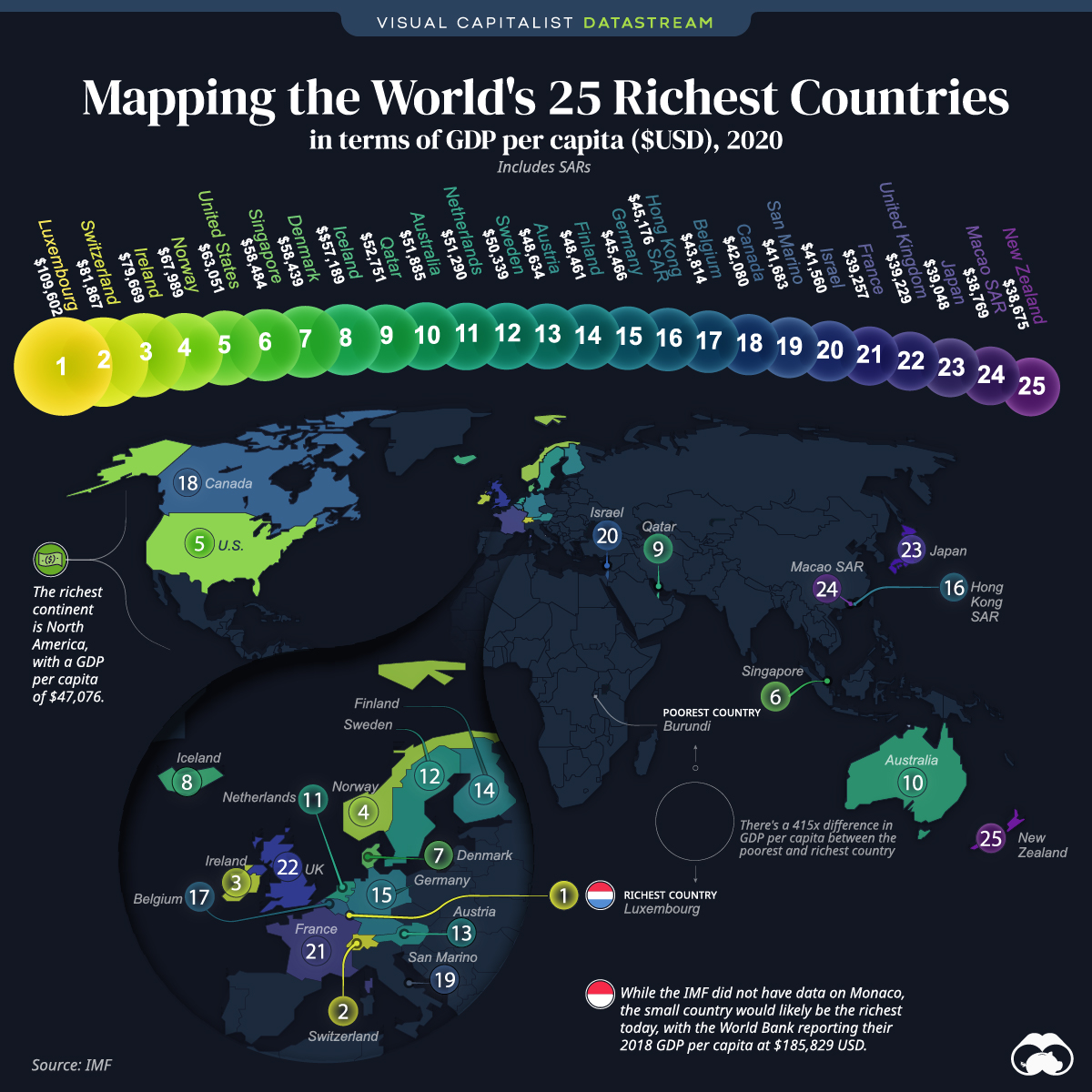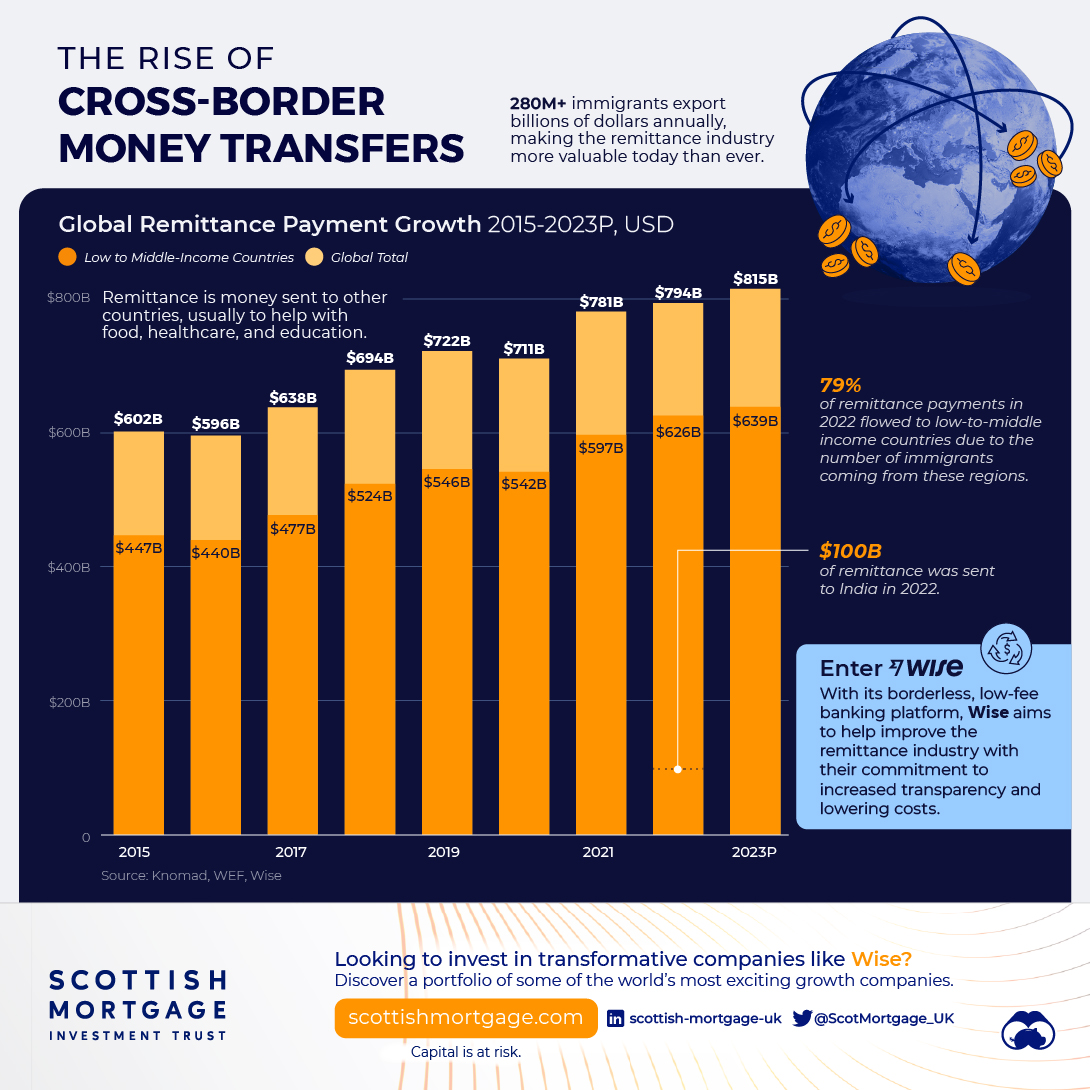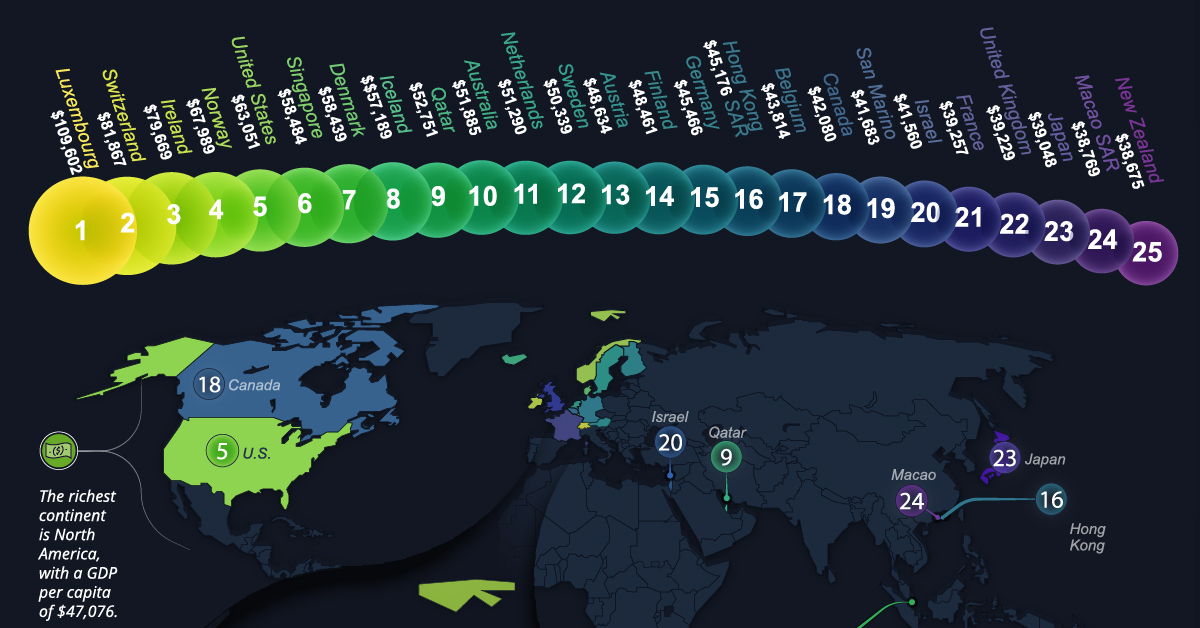Datastream
Mapped: The 25 Richest Countries in the World

The Briefing
- The richest country in the world is Luxembourg with a GDP per capita of over $109,000
- The world’s 25 richest countries are located across North America, Europe, Asia, and Oceania
Mapped: The 25 Richest Countries in the World
Which are the richest countries in the world, by nominal GDP per capita?
This map looks at the top 25 countries by this metric. They’re located across North America, Europe, Asia, and Oceania. Notably, no South American or African countries make the list.
| Country | GDP per capita (USD) |
|---|---|
| 🇱🇺 Luxembourg | $109,602.32 |
| 🇨🇭 Switzerland | $81,867.46 |
| 🇮🇪 Ireland | $79,668.50 |
| 🇳🇴 Norway | $67,988.59 |
| 🇺🇸 United States | $63,051.40 |
| 🇸🇬 Singapore | $58,483.96 |
| 🇩🇰 Denmark | $58,438.85 |
| 🇮🇸 Iceland | $57,189.03 |
| 🇶🇦 Qatar | $52,751.11 |
| 🇦🇺 Australia | $51,885.47 |
| 🇳🇱 Netherlands | $51,289.57 |
| 🇸🇪 Sweden | $50,339.20 |
| 🇦🇹 Austria | $48,634.34 |
| 🇫🇮 Finland | $48,461.48 |
| 🇩🇪 Germany | $45,466.12 |
| 🇭🇰 Hong Kong SAR | $45,175.73 |
| 🇧🇪 Belgium | $43,813.80 |
| 🇨🇦 Canada | $42,080.10 |
| 🇸🇲 San Marino | $41,682.81 |
| 🇮🇱 Israel | $41,559.51 |
| 🇫🇷 France | $39,257.43 |
| 🇬🇧 United Kingdom | $39,228.52 |
| 🇯🇵 Japan | $39,047.90 |
| 🇲🇴 Macao SAR | $38,769.20 |
| 🇳🇿 New Zealand | $38,675.32 |
Although number one on the global stage in terms of total GDP, the U.S. places fifth with a GDP per capita of $63,051.
Interestingly, a number of countries with smaller population sizes have a high GDP per capita. For example, Iceland makes the top 10 at $57,189, but the island’s population is only around 342,000 people. Similarly, Luxembourg’s population is just under 633,000—but it’s the richest country in the world on a per capita basis.
Building Wealth
So how did these countries become so well off?
Looking at history, most high-income countries went through a similar linear journey. Beginning with agriculture-based economies, they went through a period of rapid industrialization, and finally became service-based economies.
In Luxembourg today, one of the top industries is banking and financial services, for example. Here’s a look at some of the top industries in the next five richest countries:
- 🇨🇭 Switzerland:
Banking and financial services, agriculture - 🇮🇪 Ireland:
Natural resources (including agriculture, fisheries, forestry, and mining), pharmaceuticals - 🇳🇴 Norway:
Oil and gas, hydropower, seafood - 🇺🇸 U.S.:
Real estate, healthcare, technology - 🇸🇬 Singapore:
Financial services, manufacturing, oil and gas
The world’s wealthiest economies will likely remain on top for the foreseeable future, though some may experience plateauing growth. In Japan, for example, the domestic market is beginning to shrink due to an aging population.
Regardless, the wealth of these countries today is astounding, with the richest country in the world having a GDP per capita of 415x more than the poorest country in the world.
Where does this data come from?
Source: IMF
Details: GDP per capita is measured in $USD, 2020. In IMF’s database, Macao SAR and Hong Kong SAR are both listed separately from China.
Datastream
Charting the Rise of Cross-Border Money Transfers (2015-2023)
With over 280 million immigrants transferring billions of dollars annually, the remittance industry has become more valuable than ever.

The Briefing
- 79% of remittance payments in 2022 were made to low and middle-income countries.
- Borderless, low-cost money transfer services like those provided by Wise can help immigrants support their families.
The Rise of Cross-Border Money Transfers
The remittance industry has experienced consistent growth recently, solidifying its position as a key component of the global financial landscape. Defined as the transfer of money from one country to another, usually to support a dependent, remittances play a pivotal role in providing food, healthcare, and education.
In this graphic, sponsored by Scottish Mortgage, we delve into the growth of the remittance industry, and the key factors propelling its success.
Powered by Immigration
With over 280 million immigrants worldwide, the remittance industry has an important place in our global society.
By exporting billions of dollars annually back to their starting nations, immigrants can greatly improve the livelihoods of their families and communities.
This is particularly true for low and middle-income countries, who in 2022 received, on average, 79% of remittance payments, according to Knomad, an initiative of the World Bank.
| Year | Low/Middle Income (US$ Billion) | World Total (US$ Billion) |
|---|---|---|
| 2015 | $447B | $602B |
| 2016 | $440B | $596B |
| 2017 | $477B | $638B |
| 2018 | $524B | $694B |
| 2019 | $546B | $722B |
| 2020 | $542B | $711B |
| 2021 | $597B | $781B |
| 2022 | $626B | $794B |
| 2023 | $639B | $815B |
India is one of the global leaders in receiving remittance payments. In 2022 alone, over $100 billion in remittances were sent to India, supporting many families.
Enter Wise
As the global remittance industry continues to grow, it is important to acknowledge the role played by innovative money transfer operators like Wise.
With an inclusive, user-centric platform and competitive exchange rates, Wise makes it easy and cost-effective for millions of individuals to send money home, worldwide.
Connection Without Borders
But Wise doesn’t just offer remittance solutions, the company offers a host of account services and a payment infrastructure that has helped over 6.1 million active customers move over $30 billion in the first quarter of 2023 alone.
Want to invest in transformative companies like Wise?
Discover Scottish Mortgage Investment Trust, a portfolio of some of the world’s most exciting growth companies.
-

 Markets6 days ago
Markets6 days agoThe World’s Fastest Growing Emerging Markets (2024-2029 Forecast)
-

 Technology2 weeks ago
Technology2 weeks agoAll of the Grants Given by the U.S. CHIPS Act
-

 Green2 weeks ago
Green2 weeks agoThe Carbon Footprint of Major Travel Methods
-

 United States2 weeks ago
United States2 weeks agoVisualizing the Most Common Pets in the U.S.
-

 Culture2 weeks ago
Culture2 weeks agoThe World’s Top Media Franchises by All-Time Revenue
-

 Best of1 week ago
Best of1 week agoBest Visualizations of April on the Voronoi App
-

 Wealth1 week ago
Wealth1 week agoCharted: Which Country Has the Most Billionaires in 2024?
-

 Markets1 week ago
Markets1 week agoThe Top Private Equity Firms by Country















